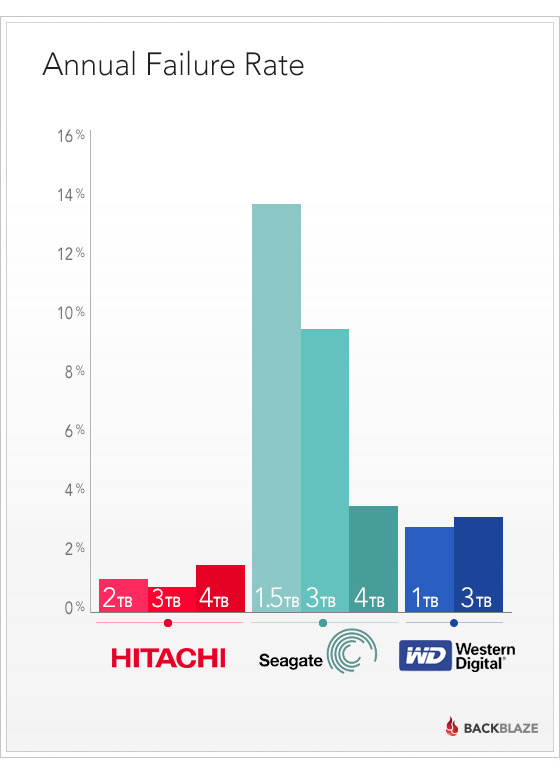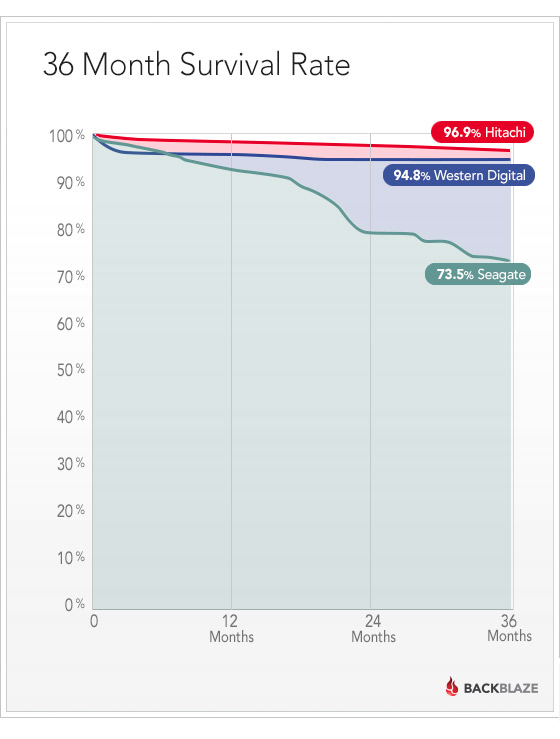PC components have frighteningly high failure and DOA rates when compared against other industries, but perhaps one of the least reliable components - and worst to lose - is the hard drive. While talking with a representative from the audio industry at CES, the point was made that "you only need to have the device fail one time before you decide to never buy from that company again." That's generally true, and is generally why we opt for WD or
Online backup provider Backblaze ran an internal reliability study on 25,000 hard drives and statistically analyzed the endurance of devices from each major company: Seagate, WD, and
It looks as if Hitachi has the lowest failure rate (best reliability) among all tested hard drive manufacturers, with WD performing second best, and Seagate performing worse than both its competitors combined (... and multiplied, twice).
Backblaze reports that hard drives tend to fail at either the 18 month or post-3-year marks. This isn't too surprising and is in-line with components across the industry. Interestingly, Backblaze even issued warranty replacements as drives failed, then tested the received units on their bench. The company notes:
"The Seagate Barracuda Green 1.5TB drive, though, has not been doing well. We got them from Seagate as warranty replacements for the older drives, and these new drives are dropping like flies. Their average age shows 0.8 years, but since these are warranty replacements, we believe that they are refurbished drives that were returned by other customers and erased, so they already had some usage when we got them."
| Number of Hard Drives by Model at Backblaze | ||||
| Model | Size | Number of Drives | Average Age in Years | Annual Failure Rate |
|---|---|---|---|---|
| Seagate Desktop HDD.15 (ST4000DM000) | 4.0TB | 5199 | 0.3 | 3.8% |
| Hitachi GST Deskstar 7K2000 (HDS722020ALA330) | 2.0TB | 4716 | 2.9 | 1.1% |
| Hitachi GST Deskstar 5K3000 (HDS5C3030ALA630) | 3.0TB | 4592 | 1.7 | 0.9% |
| Seagate Barracuda (ST3000DM001) | 3.0TB | 4252 | 1.4 | 9.8% |
| Hitachi Deskstar 5K4000 (HDS5C4040ALE630) | 4.0TB | 2587 | 0.8 | 1.5% |
| Seagate Barracuda LP (ST31500541AS) | 1.5TB | 1929 | 3.8 | 9.9% |
| Hitachi Deskstar 7K3000 (HDS723030ALA640) | 3.0TB | 1027 | 2.1 | 0.9% |
| Seagate Barracuda 7200 (ST31500341AS) | 1.5TB | 539 | 3.8 | 25.4% |
| Western Digital Green (WD10EADS) | 1.0TB | 474 | 4.4 | 3.6% |
| Western Digital Red (WD30EFRX) | 3.0TB | 346 | 0.5 | 3.2% |
| Seagate Barracuda XT (ST33000651AS) | 3.0TB | 293 | 2.0 | 7.3% |
| Seagate Barracuda LP (ST32000542AS) | 2.0TB | 288 | 2.0 | 7.2% |
| Seagate Barracuda XT (ST4000DX000) | 4.0TB | 179 | 0.7 | n/a |
| Western Digital Green (WD10EACS) | 1.0TB | 84 | 5.0 | n/a |
| Seagate Barracuda Green (ST1500DL003) | 1.5TB | 51 | 0.8 | 120.0% |
Backblaze also statistically analyzed the rate at which each company's drives died, noting a higher initial failure rate for WD than either
With this data noted, it's generally a good idea to burn-in test your components upon receipt to ensure long-term reliability, as we've written before. For hard drives, using a tool like iometer or HD Tune (both with free versions) can help perform a burn-in test. Use one of these to root-out any rapidly-failing drives before committing important data to them.
Read more of Backblaze's report here -- definitely interesting.
- Steve "Lelldorianx" Burke.

